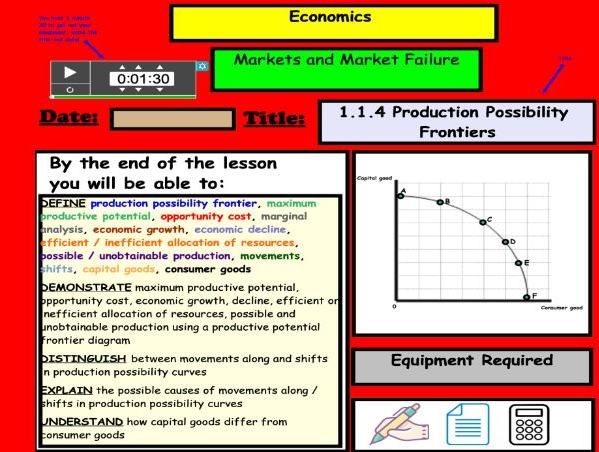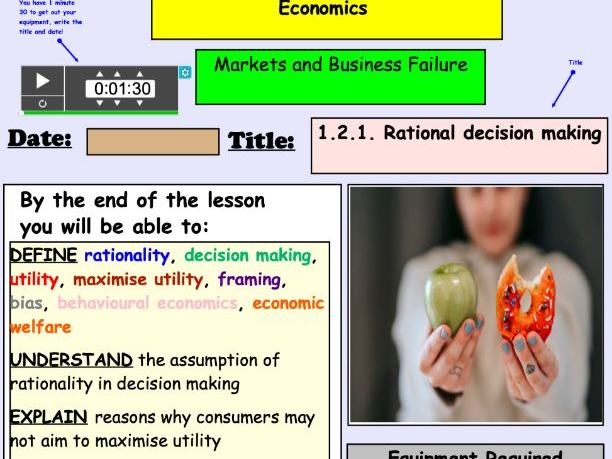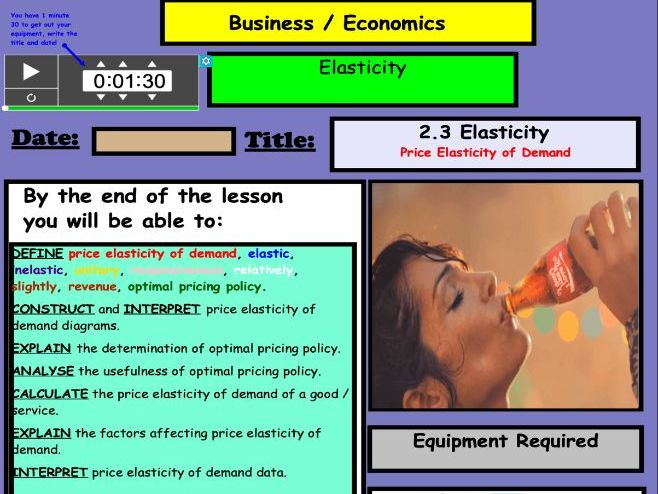84Uploads
12k+Views
6k+Downloads
Economics

Introduction to Inflation
This lesson introduces students to what inflation is and how it is measured.
Included in this presentation is:
A worksheet with answers
Colourful and informative slides with animations
Videos
Activities
Exam questions
Answers have been provided throughout

Economic Growth Multiple-Choice Questions
This is a simple activity comprising of 20 multiple choice questions on the content covered through the topic on economic growth, such as types of GDP, purchasing power parities, index numbers, subjective happiness, limitations of using GDP to measure economic growth.
All answers are included

Quantitative Skills (Economics) Worksheet
This is a simple activity for students to practice some of the quantitative skills and topics covered in A Level Economics, such as elasticity, terms of trade and the multiplier, business objectives.
There are 50 questions with answers included

Human Development Index
A lesson that explains what HDI, how it measured and other measured of development.
Explanations, editable starter activities and videos included

Interpreting elasticities worksheet
Attached is a worksheet on PED, XED, YED and PES.
Students need to calculate the values as well as interpret what the values mean, such as whether demand is price elastic or inelastic (PED), or if goods are complements or substitutes (XED), etc.
There are 16 questions in total.
All answers are included, allowing you or the students to review and grade the worksheet.

Economics as a Social Science WORKSHEET
Included in this worksheet:
Activity 1 - Match the key term with the definition based on key terms included in this topic, such as the economic problem, utility and ceteris paribus
Activity 2 - Challenge the economic assumptions (a key skill for an A/A*)
Activity 3 - Select whether the scenario is micro or macro
Activity 4 - Trivia on UK economy in 2024
All answers are included so the activity can be marked by the teacher / peer / self marked
The activity took around 10 minutes for my students to complete

Consumer and Producer Surplus
Included in this PowerPoint:
Colourful and engaging slides
Guess the question starter activity with answers (questions and answers cna be changed)
Detailed notes
A range of activities throughout with answers
Step by step demonstrations on how to show and calculate both the consumer and producer surplus
This presentation contains 38 slidea and took me an hour to go through with students

Globalisation / Introduction to International Marketing
Using MCDONALD’S TSUKIMI BURGER, Tesco’s failure to succeed in the US, Apple’s failure to succeed in India, and many others, this PowerPoint seeks to explore the reasons why businesses wish to sell in international markets, the challenges and constraints.
Included in this PowerPoint:
A detailed title page, outlining the key skills covered in this topic
A recap on moving averages with answers. This topic is included in some syllabi earlier in the marketing unit but can be deleted if not required
A starter activity introducing the concept of globalisation where students need to match McDonalds products based on the country whey are sold
(demonstrating how products need to be adapted based on the market they are targeting). Answers are provided
An explanation of reasons why businesses choose to sell products in overseas markets
A contextualised example for each reason
Detailed explanations as to each of the reasons why how marketing activities need to change depending on which country goods are being sold
Video 1: Reasons why Tesco failed in US (poor marketing)
Video 2: Reasons why Apple failed in India (poor marketing)
Introduction to some of the factors that make trade between countries easier
This lesson took me an hour and a half to go through.

Positive Normative Worksheet and Teams Form Quiz
Save yourself some time with this multiple-choice question activity on positive and normative statements, and the economic problem.
You can either use:
The paper worksheet of 44 questions with answers included. Students can peer mark this to save you time
AND / OR
The same activity but with an additional 5 questions as Teams Quiz you can set for classwork or homework. The activity self marks once students finish the quiz so that you can download the results after to see how they have done. The link for you to duplicate and download this has been included at the end of the worksheet.
This resource has been designed to save you time…
Teaching shouldn’t just be about work - get yourself down to the pub / spend some time with your family / go for a walk!
Please let me know if you have any issues / questions

Price Elasticity of Demand WORKSHEET
A detailed and colourful worksheet designed to test a range of skills covered in this topic. The worksheet contains 6 activities, each taking between 5 and 15 minutes to complete. It took most of my students between 45 minutes and an hour to finish this worksheet. The activities are as follows:
Activity 1 - A fill the blanks activity that test students’ knowledge of the vocal and terminology used
Activity 2 - Calculating PED, percentage changes and recognising the different types of PED
Activity 3 - ‘Developing your answers’ - students need to recognise and explain factors that influence PED
Activity 4 - Revenue boxes
Activity 5 - Diagrams
Activity 6 - More complex calculations / application
ALL ANSWERS ARE PROVIDED IN DETAIL and have been written in a way that is broken down for students to easily understand. I ran this activity as a peer marking exercise and collected everyone’s work at the end of the lesson to check if there were any gaps in understand to review the following lesson. This saved a lot of time!

Production Possibility Frontier
A colourful, informative and engaging PowerPoint lesson on the production possibility frontier / curve (PPF/PPC).
Included in this lesson are:
A colourful and detailed title slide providing detailed learning objectives
A discussion starter activity that introduces the concept of choice
A mix and match activity where students need to identify and explain the difference between economic and free goods
Detailed notes
Consumer goods activity
Step by step break down of what the PPF is, opportunity cost, how it is calculated, marginal analysis, movements, shifts
There is also a free blank template of a PPF on my store that you can print and get students to fill in as it is explained

Allocative Efficiency (Economics)
Arguably the trickiest of the efficiencies students need to understand.
This presentation has been designed to break this efficiency down and explain it step by step.
Productive and dynamic efficiency also recapped in a starter activity.
Lots of activities included in the presentation.
Last few slides go through exam technique for 8-markers (Edexcel) with a sample question and model answer

Rational Decision Making
This resource is a 17 slide PowerPoint that explains the concept or rational decision making.
Included in the presentation:
A colourful and informative title slide that outlines the learning objectives
An engaging and interactive online ‘vortex’ starter activity. Students need to match which key term links with which of four topics. Activity is self marked and instructions are included
Explanations of how rational decision making is a principle of neo-classical economics
Contextualised examples of how customers don’t always act rationally (Nudge Theory, Third Decoy, Dopamine, FOMO)
Explanation as to why consumers may not act rationally
This resource took me 30 minutes to complete

Free, Mixed and Command Economies
The PowerPoint attached is an informative presentation that explains the difference between command, mixed and free market economies.
Contextualised exams provided throughout.
This presentation contains 18 slides and took me 30 minutes to go through

Economics as a Social Science (Lesson + Worksheet)
This PowerPoint presentation and worksheet has designed based on the Edexcel A Level Specification but can be applied to any exam board.
The PowerPoint includes:
Detailed and colourful title page with animations, auto calendar date, gifs and timer
Starter activity that test students’ understanding of economic terminology they should be familiar with in the news
Detailed explanation of what economics is
Challenging assumption activity
Detail notes
All answers included
The worksheet has 4 activities:
Match important key terms relating to this lesson
Challenge the assumption activity
Micro or macro scenario
UK economy trivia

Price Elasticity of Demand
Colourful. Engaging. Informative. This PowerPoint has been creating to introduce students to the concept of price elasticity of demand.
Included in this PowerPoint:
A detailed and colourful title page, highlighting the skills that will be covered over the duration of this topic
A starter activity where students need to rank in order which goods / services would be most to least affected by a change in price
Discussion points
Slides detailing how price elasticity of demand is calculated, with an example
Slides explaining what the numerical values mean (how to interpret them)
Calculation questions with answers
Explanation of the factors affecting price elasticity of demand
This resource took me one hour to go through as a class

Rational Decision Making (Economics)
17 slides in total, including a fun starter activity
This presentation took me 30 minutes to go through with my class

Demand and the Demand Curve
A PowerPoint presentation on demand includes:
Catchphrase starter activity
Demand activity (graph paper required)
Detailed explanations of demand, reasons for shape of demand curve, movements, shifts, ceteris paribus
This lesson took me 60 minutes to go through

Specialisation (Economics)
This lesson introduces the concept of specialisation and the division of labour

Indirect Taxation WORKSHEET
A worksheet that tests understanding of directly and indirect taxation.
There are 4 activities in this worksheet:
A fill the blanks activity that tests students understanding of types of direct and indirect taxation and the correct terminology used depending on the tax being discussed
An activity where students need to calculate tax per unit, incidence on producers, consumers and government revenue
An activity where students need to explain why the incidence on the producer / consumer changes depending on the price elasticity of demand
An extension of activity 2 where students are given 4 additional diagrams where they need to complete additional calculations and label the incidence / tax revenue
3 multiple-choice questions on indirect taxation
Detailed answers of all* activities are provided in this worksheet
This activity took between 20 and 30 minutes for my students to complete




















